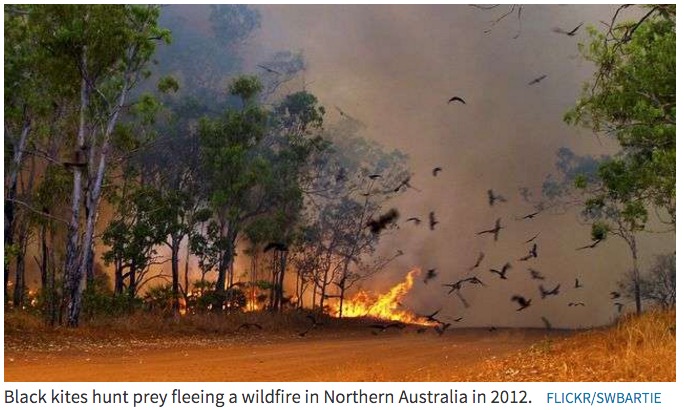On 16 occasions in the past we have jokingly used the term “animal arson” when a critter played a part in starting a fire. Examples include a mouse chewing through a power cord (and for a while was thought guilty of manslaughter), a dog chewing on strike-anywhere matches, a pigeon and a sparrow carrying lit cigarettes to their nests, a bird dropping a fish onto a power line, and a bird’s wings contacting two power lines.

There may be more to this than we originally thought. Researchers have documented multiple instances of anecdotal evidence leading to the belief that birds have helped spread wildfires in Australia’s Northern Territory. There are two primary suspects, the black kite, Milvus migrans and brown falcon, Falco berigora, but other birds of interest are the grasshopper buzzard, Butastur rufipennis in central Africa, and the crested caracara, Caracara cheriway in the southern United States.
Black Kites are found on four continents, but not in North or South America. They feed on small live prey, fish, lizards, carrion, large insects, and have been known to take birds, bats, and rodents. They are attracted to vegetation fires and will fly in from miles away to dine on small animals escaping the flames.
They like it so much that it is believed they keep the fire going by picking up burning twigs in their claws and carrying it some distance to a patch of unburned vegetation. They will wait with their feathered friends until the fire gets going and their table is set, and then grab the scurrying critters. If the fire slows down too much in that area, the story goes, they will find another burning twig to propagate the fire again.
There is also an account of a black kite dropping bread in a river. When fish congregated around the bait, the kite dived in for a meal. It is not a huge stretch from using bread as bait to carrying fire in order to herd small animals.
The evidence to support this behavior is all anecdotal, but it has aroused the interest of scientists Bob Gosford and Mark Bonta who presented some of their preliminary research on this issue at the Raptor Research Foundation meeting in Sacramento, California November 8, 2015. Their presentation included this theory:
It is also possible that humanity’s acquisition and manipulation of fire may be a result of the observation of intentional avian pyrophilic behaviour rather than solely from some relationship with lightning-caused fire.

